Tested: 1995 Supercar Olympics
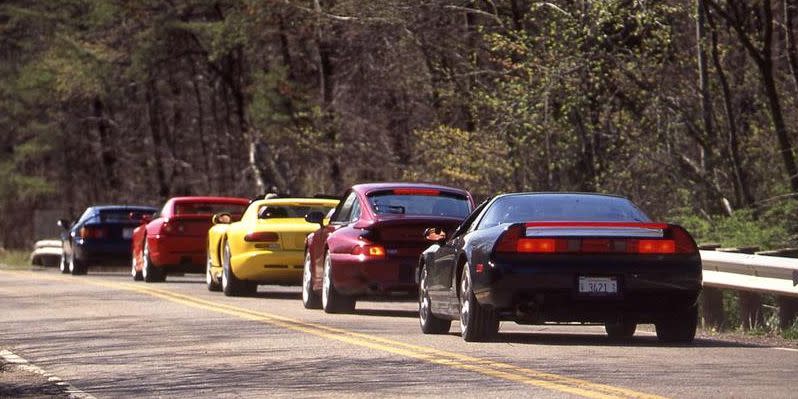
From the July 1995 Issue of Car and Driver.
In 1897, Captain S.A. Swiggett wrote a book called The Bright Side of Prison Life. It occurred to me to take a copy to southern Ohio, where we were testing five supercars, any one of which could get me arrested while cruising in second gear on eastern interstates. Our assault on Ohio's scenic Hocking Hills would be swift and international in flavor. In total, we had 1745 horsepower on tap, from $472,000 worth of exotica. And our five supercar contestants represented five countries: America (Dodge Viper RT/10), Germany (Porsche 911 Turbo) Great Britain (Lotus Esprit S4S), Italy (Ferrari F355), and Japan (Acura NSX-T). Think of it as the Olympics of supercars.
The newest weaponry on the supercar scene—the Porsche and Ferrari—triggered this comparison test. In making our other selections, there seemed no good reason to include anything with a price higher than the Ferrari's $128,800, and all five voting editors agreed it wouldn't have changed the outcome anyway. Before the Anglophiles complain, remember that the McLaren Fl is not legal here. Subscribers enamored of Italian machinery should note that the Ferrari F50 isn't ready yet, and no Bugatti EB110 has yet been sold in America. Red-white-and-blue patriots should similarly recall that the Corvette ZR-1, which admittedly would have been a better-rounded ambassador than the Dodge Viper, went the way of the passenger pigeon one month before this story would appear.
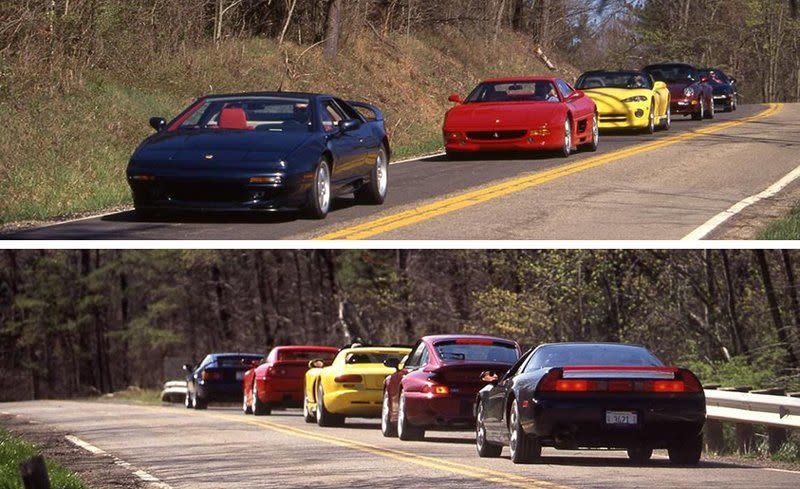
Our vehicles thus assembled, it was curious to discover that, quite without trying, we wound up with no similar engine architectures. The engines include a single-turbo inline four, a twin-turbo flat-six, a DOHC V-6, a 40-valve V-8, and a pushrod V-10. The Lotus, the Ferrari, and the NSX are mid-engined. The Porsche is rear-engined. The Viper is front-engined. From a styling standpoint—at least according to Ohio and Michigan citizens who rushed us at every fuel stop—not one of these vehicles looks very much like any other.
So what did we hope to discover in one week of driving? We, needed to know which was the fastest, and we found out after just one day at Ohio's sprawling Transportation Research Center. The intangibles were trickier. Which car is easiest to drive at nine-tenths on public roads? Which impresses onlookers most? Which is the most fun to drive, never mind its performance envelope? Which is the most potent and comfortable long-distance tourer? Which is the most passionate? Which feels the least likely to spend its life atop a service hoist?

It took a week of nonstop driving and late-night arguing to find out, during which interval we pushed the vehicles hard enough that both the NSX and the Viper had to be retrieved from ditches. Said C/D godfather Brock Yates, as he brushed pieces of hemlock bough and sandstone grit off his vest: "At about 90 percent of their capabilities, all five of these cars are hugely competent and benign, lulling their drivers into Fangio-like confidence. But put one toe over the edge and there's an excellent chance you'll get to help refurnish your insurance agent's new home in Grosse Pointe."
Or, to put it another way, begin memorizing passages from The Bright Side of Prison Life.
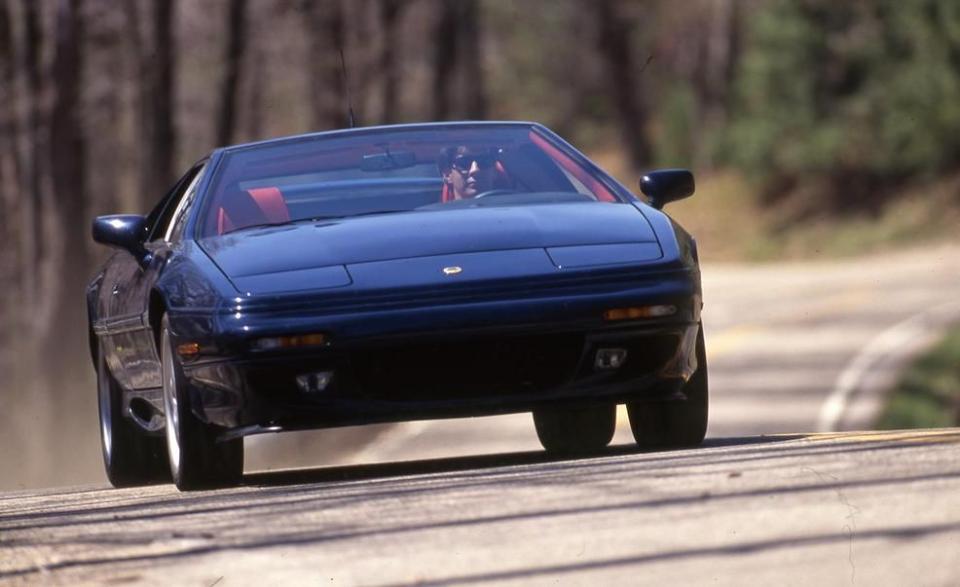
Fifth Place: Lotus Esprit S4S
Twenty years ago, our first test of a Lotus Esprit offered this keen insight: "The factory is frank about the Esprit's unsuitability for grand touring . . . the twin tanks should be filled with gas destined to be burned in bursts of back-road berserking."
Not much has changed in two decades, although thanks to a larger Garrett turbo and larger inlet valves, the Lotus's maniacally peaky 2.2-liter four-banger now delivers an even more berserk steady-state 285 hp and briefly as much as 300 hp, if the weather on Route 595 near Logan, Ohio, is sufficiently cool and dry. When the turbo kicks in at around 2700 rpm, it's like being smacked in the back of the head with a warped nine-iron. A kind of blurry trauma ensues. Full boost in the rain will light up the rear tires in first, second, and third gears. At which point, the Esprit's tail yaws right on crowned roads, the driver countersteers like Damon Hill, then the whole mess straightens out after a vicious snap that leaves onlookers wondering if you've lost your mind or are just insanely rich. Or both.
The 60-mph barrier topples in 4.4 seconds, making the Esprit quicker in a straight line than a 405-hp Corvette ZR-1, which possibly did not amuse Detroit engineers back when GM owned Lotus.
There is much about the Esprit that is race-car-like. The pedals are skewed inboard and are so close together that Simpson's best Nomex booties are recommended. The steering is knife-like and fast, although it is a great match for the car's flat, neutral cornering stance. Once you push through the surging andsucking power assist for the Brembo brakes, you have exactly the pedal feel you'd want in Turn One at Long Beach.
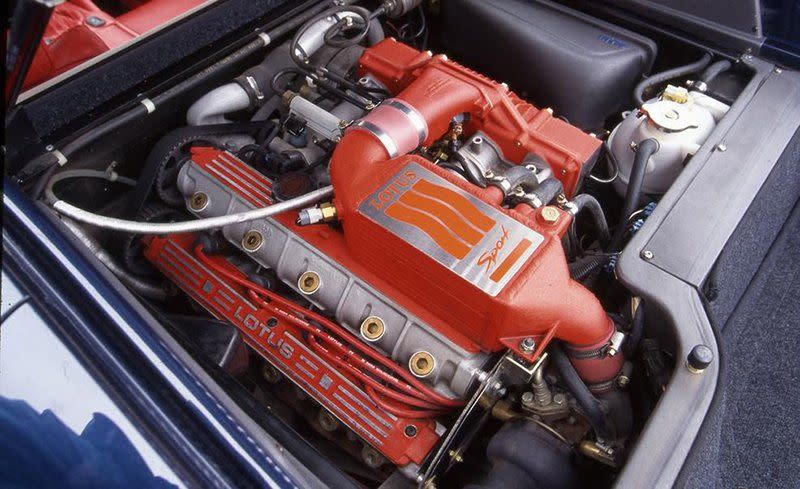
Far less race-ready is the Renault-based gear linkage, a high-effort yet mushy affair. "It's like making a long-distance call to Paris to make a gearchange," says Kevin Smith. It is also fragile, not a good trait in turbo cars, which encourage quick shifting to keep the boost on the boil. This may explain why second gear was no longer with us at the end of this test. Similarly unrefined is the Esprit's powerplant, which bangs and bucks as if it were a 2.2-liter K-car engine forced to produce the highest specific output of any in-line four in America. Not a far-fetched analogy.
Still, the Esprit's cuneiform figure—its waist-high profile, even its gaudy wing that overreaches the rear bumper—makes onlookers gawk and chase, although they rarely know what they're looking at. They mouth the word "Lotus," then say, "Oh, the Pretty Woman car." But they always assume that it costs more than its $80,340 base.
Cranky, quirky, and as breakable as Waterford crystal, the Lotus finished last but by only two points. It is eccentric (hell, when did you last hear of a supercar getting a 27-mpg EPA highway rating?), a lean point-and-squirt machine for nasty, unpredictable roads. Such as the wicked little lanes around Norwich. Think of it as half Formula Ford made street-legal, half Barbara Woodhouse on PCP.
1995 Lotus Esprit S4S
300-hp inline-4, 5-speed manual, 2969 lb
Base/as-tested price: $80,340/$87,904
C/D TEST RESULTS
60 mph: 4.4 sec
1/4 mile: 13.0 @ 108 mph
Braking, 70–0 mph: 189 ft
Roadholding, 300-ft-dia skidpad: 0.94 g
C/D observed fuel economy: 17 mpg
Fourth Place: Dodge Viper RT/10
The Dodge Viper is the antithesis of the Lotus. Where the Lotus is a kind of .22-caliber Olympic target pistol, the Viper is simply an 16-inch cannon yanked off the deck of the USS Missouri. The Lotus is the lightest car in the group, the Viper is the heaviest. The Lotus has the smallest engine in the group, the Viper's 488-cube thunderbox is the most mammoth passenger-car powerplant in production. The Lotus offers the fastest lane-change capability, the Viper possesses the slowest.
Yet in this comparo, the Viper occupies fourth place rather than fifth. Here are three reasons: (1) big torque exists at any engine revolution, (2) its shape evokes involuntary seizures among all onlookers, and (3) it has the lowest sticker price in all of supercardom.
Of course, there are good reasons for the Viper's bargain-basement $62K tariff. No roof, for instance. And a hose-it-down plasticky interior with low-rent switch-gear. And a ride like a Ford F150's. And a full-throttle exhaust blat that sounds like a tornado ripping out the seams of a Holy Rollers' revival tent. All of which we graciously accept, because it's precisely what Chrysler promised back in 1992. What we didn't count on was this car's spooky steering and villainous handling.
The Viper hunts and darts under braking. It resolutely follows even minute irregularities in the road. Its rear end steps out when you poke the power. And, as Csaba Csere describes it: "There's a moment where nothing happens between turn-in and when the tires actually hook up. It saps your confidence if you're hustling."
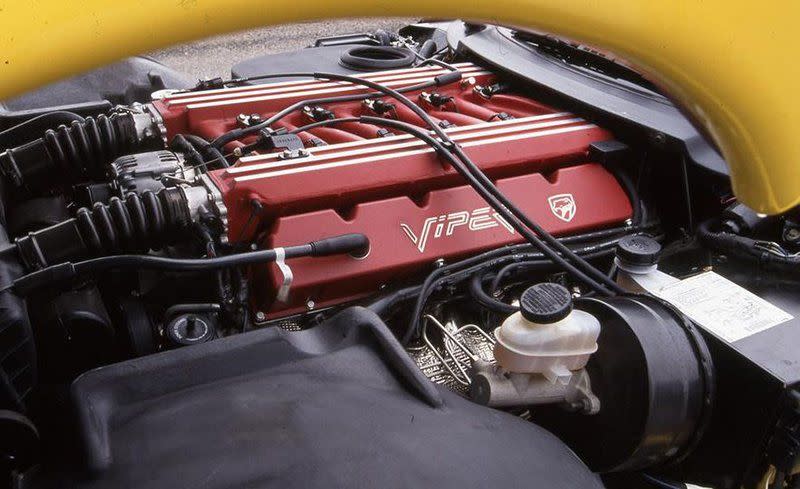
The snaky handling ("This is the only car I've ever spun on the skidpad," notes Don Schroeder) is likely a result of unfinished development. God knows, the Viper has all the rubber it could ever want, and its weight bias is the closest to perfect in this group—an astounding claim for a car whose nose carries an engine the size of John Madden's refrigerator.
In many ways, owning a Viper is like owning a powerful motorcycle. "Without a real top, it's too reliant on the weather,' says Kevin Smith, who also noted that removing and replacing those rudimentary canvas pieces is a tedious, fussy, two-mar job. "Yeah, it's the world's largest Fat Boy Harley," added Yates, "and you might even want to put your feet down roaring into turns—this is the only non-ABS - equipped car in the bunch." Also the only one without even a single airbag.
Although it's tied with the 911 Turbo in the horsepower wars, the Viper accelerates to 60 mph and through the quarter-mile half a second slower. Put 400 horsepower in nearly any street car and you might want to think about four-wheel drive, a concept that was implemented in Weissach but not at the New Mack Assembly Plant.
The Viper is like using a Louisville Slugger to play ping-pong. You wind up with drastic, if clumsy, results. It is big, crude, deafening, and something of a cartoon. "On the other hand," noted Yates in the logbook, "every time we'd show up in a small town, the locals clumped around one car and one car only: the one built in Detroit."
1995 Dodge Viper RT/10
400-hp V-10, 6-speed manual, 3534 lb
Base/as-tested price: $61,975/$61,975
C/D TEST RESULTS
60 mph: 4.3 sec
1/4 mile: 12.8 @ 109 mph
Braking, 70–0 mph: 180 ft
Roadholding, 300-ft-dia skidpad: 0.98 g
C/D observed fuel economy: 14 mpg
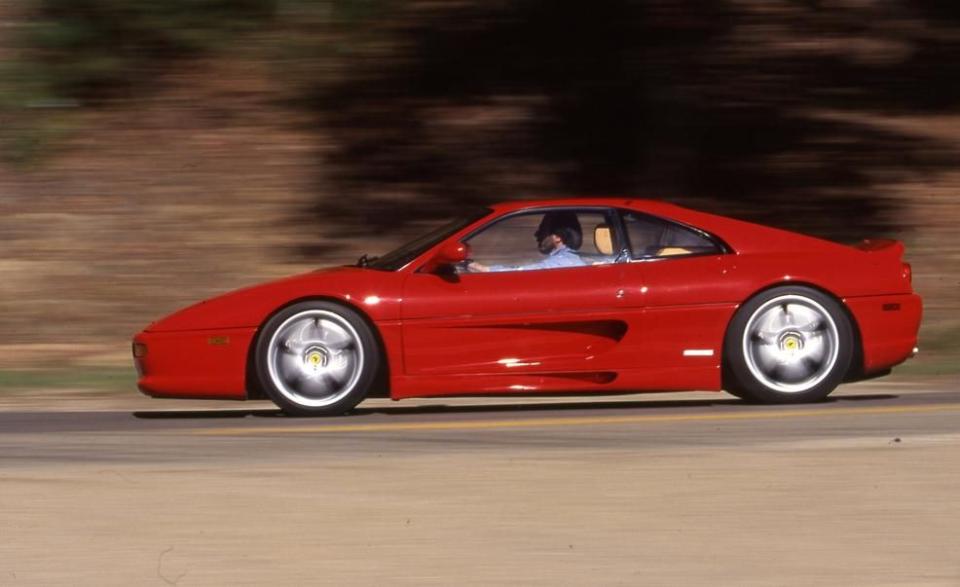
Third Place: Ferrari F355
For Ferrari, the F355 is a radical departure. Don't believe us? Consider one entry in its logbook: "This car has a climate-control system that really works; in fact, it works better than the Porsche's."
C/D has traditionally been slow to praise Ferraris, in part because the manufacturer's performance claims tend to be inflated, in part because the cars have been impractical and unreliable, in part because their sticker prices gave us nosebleeds.
So check out the stats on the company's newest and cheapest offering: 0-to-60 and quarter-mile times only 0.2 second behind the 400-hp Viper's. A stopping distance so close to the Porsche's that Stuttgart's engineers may pull a full Jonestown Kool-Aid klatch. And skidpad grip that, at 1.02 g, not only surpasses everything in this comparo but also bests the company's own street-legal racer, the F40.
Add to that terrific steering with power assist as nearly perfect as the NSX's, not to mention better visibility. Plus a ride that is taut without becoming harsh, not what you'd expect from a one-g suspension. Plus an 8500-rpm redline that produces an engine howl so sonorous, so much like a lightly muffled F1 car, that the driver doesn't really miss the optional radio. (Hey, you want everything for only $128,800?)
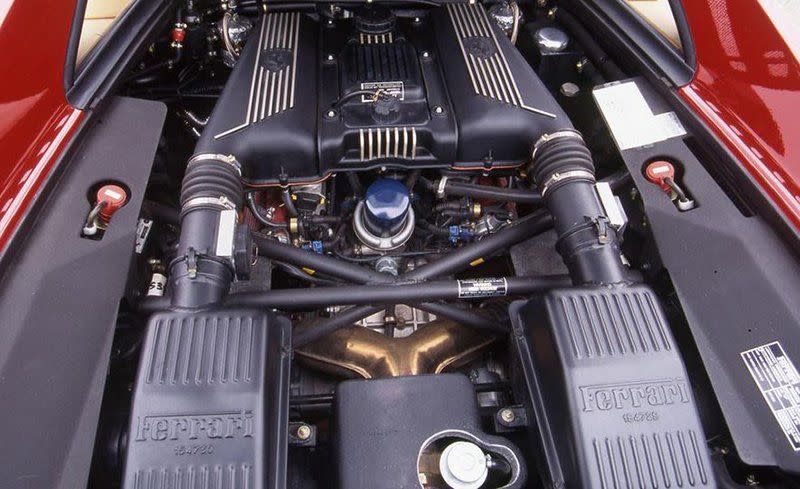
"In the details of this car, Ferrari has done a lot of what Acura did to define itself, way back when," wrote Kevin Smith. Indeed, the F355 offers adjustable shocks, unique in this group. It has firm seats that can be twisted into a wide variety of supportive shapes, plus a sophisticated exhaust bypass that meets emissions regs without strangling the 375-horse V-8.
Although it's on such a clear course to modernizing its cars, Maranello ought to continue improving them. The gated, metallic shifter is still a chore and a gratuitous anachronism. The steering wheel, although adjustable, gives you the choice of either a good driving position or viewing the instruments, but not both. Moreover, this is the second F355 we've tested whose sticky throttle made it impossible to pick up the power smoothly in mid-corner. And this engine's 24 inlet valves are so deft at swallowing accelerants that the F355's cruising range (when the fuel light began to glow) averaged just under 200 miles. (Yes, we were driving like Gerhard Berger, though not as neatly. But fuel economy worse than a 488-cubic-inch Viper? Don't tell the Vatican.)
Only two points out of second place, the Ferrari was the Big Surprise in this comparo. "If the thing just cost a little less—say, the same as the Porsche," noted Kevin Smith, "it would easily have been in second place. In fact, I might have voted it the winner."
1995 Ferrari F355
375-hp V-8, 6-speed manual, 3270 lb
Base/as-tested price: $128,800/$128,800
C/D TEST RESULTS
60 mph: 4.5 sec
1/4 mile: 13.0 @ 110 mph
Braking, 70–0 mph: 165 ft
Roadholding, 300-ft-dia skidpad: 1.02 g
C/D observed fuel economy: 13 mpg
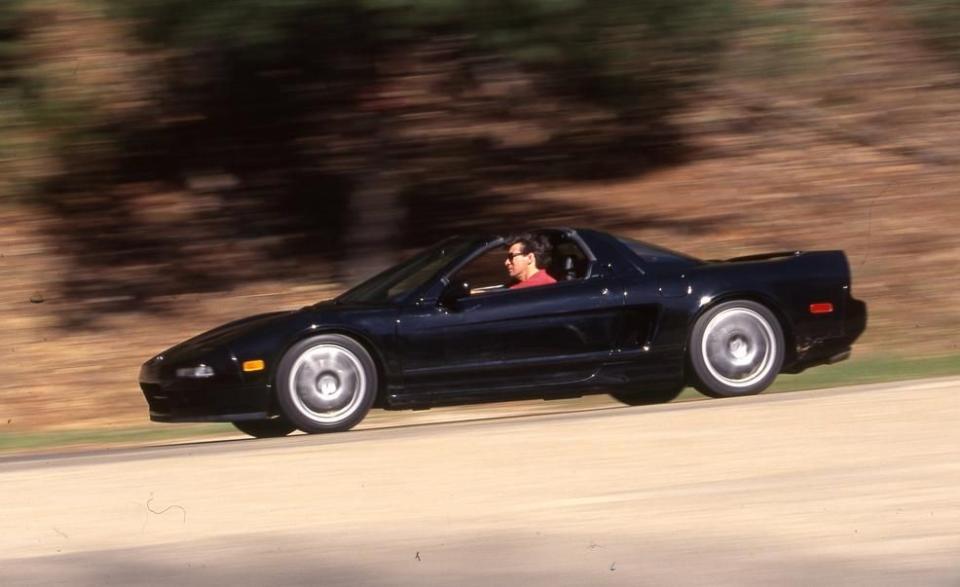
Second Place: Acura NSX-T
For the last five years, we've regularly gushed and spouted and pontificated about the essential goodness, the quintessential purity, of Acura's NSX. So don't be shocked that this, the least powerful car in our super five (and also the slowest to 60, mph and through the quarter-mile), finished only three points behind the fastest, most powerful car in the group.
How can this happen? Here's how: track numbers tell you zip about a car's usable performance in Ann Arbor traffic, and they tell you little about making nine‑tenths passes on the blind, downhill, off-camber turn just outside Burr Oak Lodge.
The Acura NSX is as user-friendly as the tumblers on a Mosler vault. Check out the expansive view from its low, forward cockpit. Try finding a clutch and shifter combo that so telepathically slides gears into place. See if you can locate any seats that are both this comfortable and this adept at distributing side forces. Locate a steering rack that delivers this much feedback sans kickback. Identify a removable targa top that can be stowed onboard without reducing cargo-carrying capacity by one cubic inch.
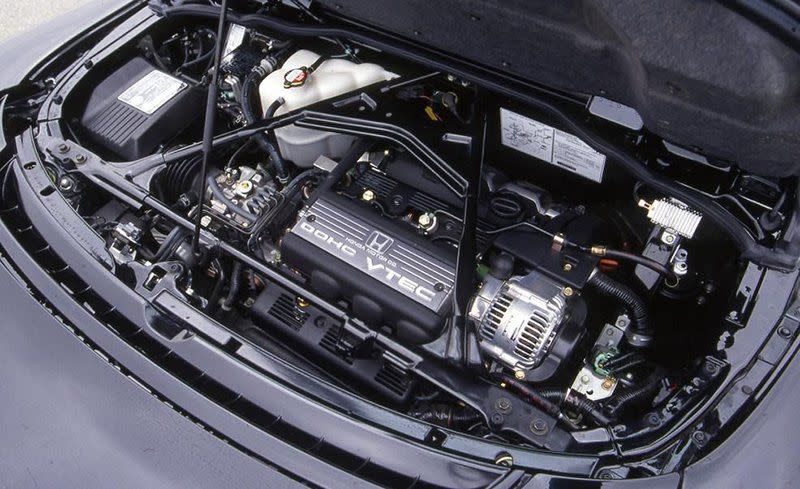
Built with the same monumental attention to ergonomic detail as a Honda Accord, the NSX sometimes takes a knock or two for being too familiar, at least inside, where some of the switchgear is pedestrian and the cockpit is an unnecessarily dour arena in which to celebrate so much fun underfoot. On this trip—for the first time—editors fantasized openly, if not vociferously, about obtaining more power, especially when the car was asked to launch itself out of tight uphill esses and switchbacks. One editor suggested a supercharger, another wanted a 3.0-liter V-8, a third asked whether a streetable version of Honda's racing V-10 might fit. Which, in turn, made us wonder whether a six-speed gearbox, rather than the mandatory five, might also make life easier.
At $86,642, the NSX is no longer the striking bargain it was 60 months ago. Still, where the Viper offers a huge bang for the buck, the NSX is big civil subtlety or the buck. This is the brain surgeon's approach to go-fast operations. From its bird-bones Suspension bits to its lacy aluminum skin, the NSX delivers supercar precision without beating up its owner.
But beware: Although you can throw it around; you can also throw it away.
1995 Acura NSX-T
270-hp V-6, 5-speed manual, 3110 lb
Base/as-tested price: $86,642/$86,642
C/D TEST RESULTS
60 mph: 5.2 sec
1/4 mile: 13.8 @ 103 mph
Braking, 70–0 mph: 173 ft
Roadholding, 300-ft-dia skidpad: 0.95 g
C/D observed fuel economy: 18 mpg

First Place: Porsche 911 Turbo
It's the kind of formula you'd concoct in high-school study hall. Take a chassis four inches shorter than a Jeep Wrangler's, then install a twin-turbo engine with, say, 400 horsepower hung way the hell behind the rear wheels. The result should be something akin to a golf cart powered by two General Electric turbines—the sort of car that would crash as you backed it out of your driveway.
Instead, the outcome is the most obscenely fast and sophisticated Porsche since Weissach loosed upon civilized society the all-wheel-drive 959 nine years ago. The new 911 Turbo is our choice as this planet's most eminently practical supercar, the quickest A-to-B four-wheeled transport to alight on American highways.
About now, you're probably muttering, "What about the Ferrari F40 or Lamborghini Diablo VT?" Forget 'em. If you've got 3.7 seconds to spare, the 911 Turbo will hand you 60 mph. That leaves the F40 half a second in the dust. Or, if you've got some empty road near your house, this Porsche will swallow 1320 feet of it 1.7 seconds sooner than your neighbor's Lamborghini Diablo VT.
Not that those comparisons mean much anyway. The nervous F40 and the fat Diablo are 30-minute cars. After that, you'd like a cool drink and a brief nap. Not so the 911 Turbo. Cruising around town, this Porsche is more docile than a Carrera 2, partly because it's quieter and partly because the standard luxo bits inside are more posh. And when you finally do tip into the KKK turbos, there's no tire squeal, no exhaust roar, no darty nose. Just a seamless, silent, drama-free delivery of endless torque, accompanied by a rush of scenery that within two or three seconds takes on a vaguely hallucinatory hue, as if the nearby trees were all recently vandalized by Matisse.
"Twice on brief straightaways," noted one editor in the Turbo's logbook, "I glanced down and discovered I had innocently dialed up 130 mph. I'd have been horrified if I hadn't had Porsche's brakes beneath me."

Not quite matching this machine's warp-drive potential for effortless velocity are the clutch and steering—one is uncommunicative, the other is simply too light. Porsche intentionally removed 25 percent of the clutch-pedal effort, plus 15 percent of its travel. And as for the feathery steering, well, maybe it's those new 8-by-18-inch front wheels or the GT2's racing power-assist. Whatever the reason, the more rudimentary Carrera 2's steering remains the best sports rack in the world, and we wish the engineers hadn't messed with it.
Ditto the Turbo's security system. An ignition bypass is triggered by pressing a button on the key fob. It sounds simple enough, but you can't imagine the driver's fury when he inserts the key, twists it for liftoff, and absolutely nothing happens Can you say "gimcrackery"?
We dubbed the Porsche "the lazy man' supercar," at least on the roads of southern Ohio. Although the Turbo is the second-heaviest car in this quintet, Porsche ha. pretty well masked its traditional tail-wagging-the-dog handling. Give out drivers 400 horsepower plus astounding wet-weather grip and they will—using one hand and half a head of concentration—keep up with any other supercar in this group. "It's 'almost like cheating," wrote Kevin Smith.
We'll come back to this wonderment, in part to report more definitively on some un-Teutonic assembly glitches. Our test car suffered an inoperative "Litronic" low-beam lamp, a snapped-off hood latch, a sunroof that ate fuses like popcorn, and a glovebox that randomly flopped open and spilled its considerable guts.
Still, no piece of machinery producing 400 horses has any right to feel so tame and violence-free. Said one editor, "I can't explain it, unless this car is powered by dilithium crystals." The new Porsche 911 Turbo is the German engineers' 176-mph answer to whatever the question was, or will be. Captain Swiggett should be told.
1995 Porsche 911 Turbo
400-hp flat-6, 6-speed manual, 3362 lb
Base/as-tested price: $106,465/$106,465
C/D TEST RESULTS
60 mph: 3.7 sec
1/4 mile: 12.3 @ 114 mph
Braking, 70–0 mph: 162 ft
Roadholding, 300-ft-dia skidpad: 0.95 g
C/D observed fuel economy: 14 mpg
You Might Also Like

 Yahoo Autos
Yahoo Autos 